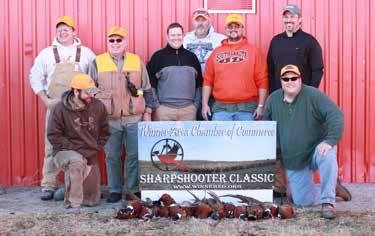
4 minute read
Winner Sharpshooter Bird and Clay Classic
BY MARIA TIBBETTS
Six shooters. Fifty shotgun shells. Twenty-one prize shotguns. Two days in Winner, South Dakota.
That’s the crux of the Winner Sharpshooter Bird and Clay Classic, an annual hunting and shooting competition that draws shooters from all over the country and right next door, said Mike Scott, executive director of the Winner Chamber of Commerce.
The competition is planned for Dec. 11 and 12 this year, after the pheasant hunting traffic has slowed, but the hunting is still good.
Each team of six hunters has four hours and one box of 25 shotgun shells between them to shoot as many pheasants as they can on private hunting ground.
This year they added a new element-- once they get back to the gun club with their birds, the teams pick five of their six members to shoot trap on the clay target range. They again get one box of shells between all five shooters.
The team with the highest score, plus the landowner who hosted them, each receive a high-end shotgun. Second and third place teams also get shotguns, but the price tag on the gun gets smaller with each placing.
The event started about eight years ago, and Mike Scott was part of the organizing committee.
“We were looking for a way to take what we do well in the community--quality hunting–to try to get more people to come back to hunt, and draw some out-of-towners. What ended up happening was we get our out-of-town hunters, but it’s turned into a local favorite event. It was a lot more popular on the local level than I thought it would be.”
Barry Tideman has been involved with the Classic since it started. He has hosted teams on his place, where he raises wheat, milo, corn and soybeans, and he has hunted on a team.
“I sure enjoyed having different guys come out and hunt. Most of them I kinda knew, but a few were out-of-staters. It’s a chance to make some new friends,” he said.
“It’s a well-run event. Part of it’s the camaraderie. Everybody looks forward to that. As far as the success of the hunt, its kinda the luck of the draw. If you get some good places to hunt, you might do real good. You might get a good place and not be able to hit anything. If you have two or three misses you might be out of the running.”

The competition starts Friday night, with a dinner and draw for hunting ground. All the ground is private, and a few of the places are preserves.
“It’s a positive for landowners,” Tideman said. “You get to show your friends your hunting operation. Out of state hunters get to see your hunting operation. We always save some land that hasn’t been hunted for a while. Nobody has been disappointed here.”
The landowners can walk with the hunters and show them where to hunt, and can take a dog to retrieve down birds. But when Tideman is hunting on a team, he can’t hunt his own land.
There is a good deal of strategy in the competition, Tideman says. “You’re really cautious and half scared about shooting. When our pay hunters are out there, they might shoot two or three times at each bird. But in the Sharpshooters you really have to think about your shot. Pretty soon you think about it too much and then you do miss. Typically, everybody takes four shells and one guy takes five. As you hunt, if somebody is really on, you pass your shells to that guy.”
There is a judge with each team, who walks and brings the birds in at the end of the competition. Each bird and each clay pigeon have a point value and the team with the most points at the end of the day is declared the winner.
The winners are recognized at a banquet on Saturday night, and additional prizes and raffles are awarded.
The fee to enter the competition is $1,800 per team, which includes meals both Friday and Saturday, shotgun shells, the bird cleaning and four hours of hunting on private property, said Scott. Plus it puts competitors in the running for pretty nice shotguns. “It’s pretty reasonable if you break it down,” said Scott. “We try to make it a nice event. We have prime rib and that type of thing. For first place, all six shooters and the landowner get probably $1,300 to $1,400 guns. Second and third place guns are slightly less expensive, but still good quality.”
While the pheasant opener in October is typically one of the busiest of the season, this type of late-season hunt may be one of the best-kept secrets. “It’s a great hunt,” said Scott. “In December it’s cold and the birds are bunching. If you don’t mind a little cold, that’s the best time to go. There may be fewer people hunting then, but they come back because the hunting is good.”








